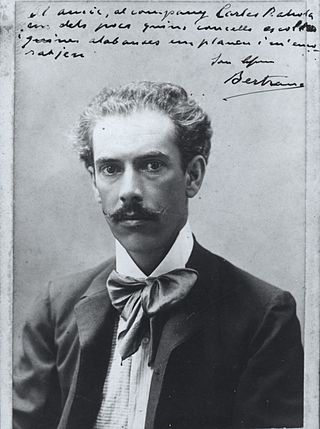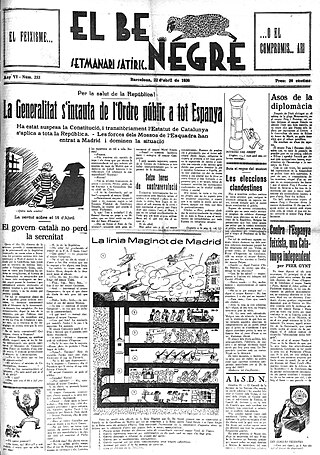
Modernisme, also known as Catalan modernism and Catalan art nouveau, is the historiographic denomination given to an art and literature movement associated with the search of a new entitlement of Catalan culture, one of the most predominant cultures within Spain. Nowadays, it is considered a movement based on the cultural revindication of a Catalan identity. Its main form of expression was Modernista architecture, but it also encompassed many other arts, such as painting and sculpture, and especially the design and the decorative arts, which were particularly important, especially in their role as support to architecture. Modernisme was also a literary movement.
José Escobar Saliente was a Spanish comic book writer and artist, born in Barcelona. He signed as Escobar, and is most famous for his creation Zipi y Zape, as well as the character Carpanta. He was also an author and a theater actor, as well as one of the pioneers of animation in Spain during the 1920s, and worked on early Spanish animated movies, such as La ratita que barría la escalerita.

En Patufet was an illustrated children's magazine, written in Catalan, published in Barcelona (Spain), between 1904 and 1938. Later, between 1968 and 1973, it was resumed under the name Patufet. It had a great popularity, to the point that the word patufet was used generically to refer to the illustrated magazines for children, now called comics. It was the Catalan weekly magazine with the most circulation (65,000) and readers weekly (325,000).
La Campana de Gràcia was a seminal Catalan weekly magazine of satire, written bilingually in Catalan and Spanish of the late 19th and early 20th century, staunchly supportive of republicanism and anticlericalism. The headquarters was in Barcelona.

Isidre Nonell i Monturiol was a Spanish artist known for his expressive portrayal of socially marginalized individuals in late 19th-century Barcelona.

Lluís Bagaria i Bou one of the most important Spanish caricaturists in the first half of the 20th century. His drawings, in a synthetic and decorative style, were published in the most important journals of Spain, including L'Esquella de la Torratxa and ¡Cu-Cut! between 1906 and 1940.
The Derbi Barceloní, is the name given to football matches between FC Barcelona and RCD Espanyol. Both clubs are located in the Barcelona metropolitan area, Spain.

Prudenci Bertrana i Comte was an important modernist writer in Catalan.

Ricard Opisso (1880–1966) was a Catalan cartoonist, caricaturist, illustrator and painter.

Lluïsa Vidal i Puig was a painter. Raised in a well-off family closely related to Catalan modernist circles, she is known as the only professional women painter of Catalan modernism, and one of the few women of that period who went abroad to receive art lessons.

¡Cu-cut! was a Catalan illustrated satirical magazine, written in Catalan. Published in Barcelona between 1902 and 1912, it followed the political line marked by Francesc Cambó's Lliga Regionalista.

El Be Negre, meaning "The Black Sheep" in Catalan, was an illustrated satirical weekly magazine. Published in Barcelona between 1931 and 1936, its life and destiny were closely linked to those of the ill-fated Second Spanish Republic.

Lo Noy de la mare was a humoristic and satiric weekly publication. It was written and directed by Conrad Roure, who used the pseudonym of Pau Bunyegas, among others. It was drawn by Tomás Padró. These two authors had previously worked in the magazine called “Un Tros de paper” and they decided to leave this publication to do “Lo Noy de la mare”. This magazine was first published in Barcelona in 1885, and it continued until 1886, with a total of 33 numbers. The magazine had a measurement of 310x217 mm and it contained 4 pages with 3 columns each. It had an enormous success but it had to be cancelled due to the moment circumstances, which were not good for criticism.

Aurora Bertrana i Salazar was a Catalan cellist and writer, notable for her exotic stories and novels. She lived in Tahiti, Morocco, Switzerland, and France. Bertrana's republished memoires combining Memòries fins al 1935 (1973) and Memòries del 1935 al retorn a Catalunya (1975) provide a detailed account of her life.

Llorenç Brunet i Forroll (1872-1939), also known in Spanish as Lorenzo Brunet, was a Spanish illustrator, caricaturist and watercolorist. He signed his works as L. Bru-Net or Bru-Net.

Irene Rocas i Romaguera (1861-1947) was a Catalan folklorist and lexicographer. Her works contributed to the research on Empordà language and literature. One of the most notable of these was the Diccionari català-valencià-balear, a collaboration with the Majorcan author Mossèn Alcover. She was the mother of the Spanish writer, folklorist, and academic, Maria Gracia Bassa i Rocas.
La Ametralladora was a weekly satirical magazine which was published during the period 1937–1939. It was distributed to the nationalists fighting in the civil war.














